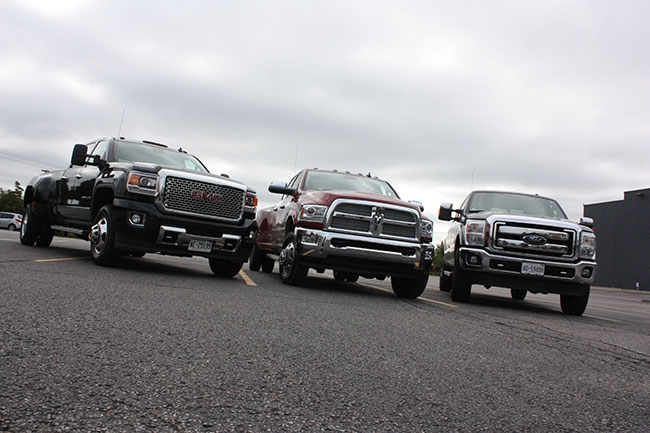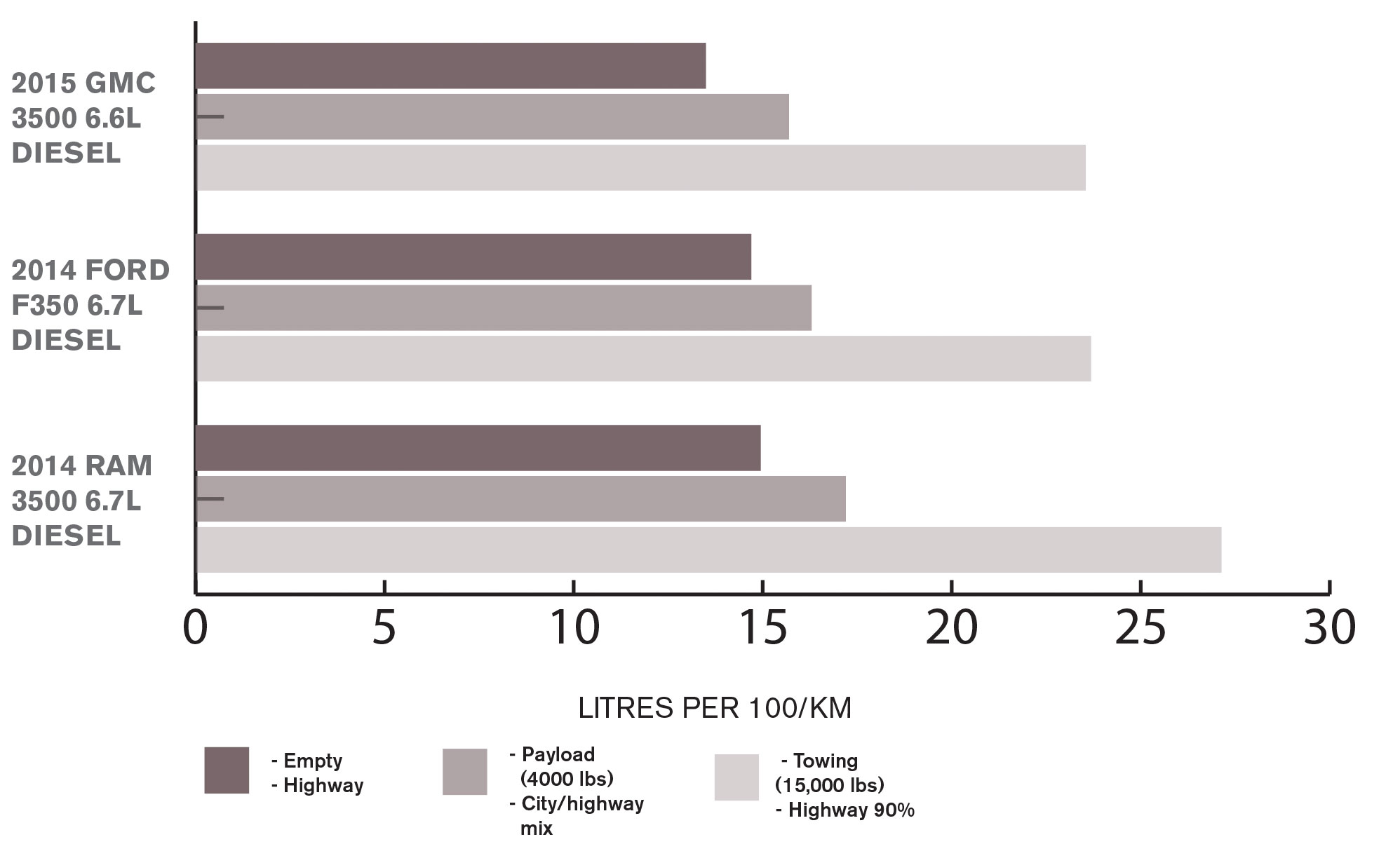
2015 Canadian HD Truck King Challenge
By Howard J. Elmer
Features Companies Equipment ProfilesHere are some heavy-duty stats to back up your next heavy-duty purchase
 Three heavy-duty pickups from Ram, Ford and GMC ran head to head at a drag strip in Grand Bend, Ont., while towing 15,000 lb. trailers of The Canadian Truck King Challenge
Three heavy-duty pickups from Ram, Ford and GMC ran head to head at a drag strip in Grand Bend, Ont., while towing 15,000 lb. trailers of The Canadian Truck King Challenge
Who rents a drag strip, borrows seven-ton fifth-wheel trailers and has five respected automotive journalists race the one-ton trucks head to head?
We do. The eighth annual Canadian Truck King Challenge did just that (and much more) to clearly show the truck-buying public who is the best of the best for 2015.
For this challenge, three heavy-duty pickups from Ram, Ford and GMC ran head to head at the MotorPlex drag strip in Grand Bend, Ont., while towing 15,000 lb. trailers as just one part of two intensive days of Truck King testing.
The outcome? The GMC Sierra 3500 beat the Ford and Ram in each heat. It would also go on to win the title.
But, back to the drag strip: a curious fact emerged during this testing. On paper the GMC boasted the least amount of horsepower and torque among the competitors. Yet it won each race. We ran it several times – with the trailer and without. It pulled away from its competition each time. And, that’s the difference between real-world testing and paper tigers.
Here are the quickest quarter miles from each truck taken from multiple runs:
GMC: 16.098 seconds when running empty, 21.932 seconds with trailer attached
Ford: 16.542 seconds when running empty, 23.303 seconds with trailer attached.
RAM: 16.927 seconds when running empty, 23.581 seconds with the trailer attached
The trap speed for all three trucks (at the quarter-mile line) was always plus/minus one MPH of 80 MPH. Trap speed with trailer attached, again for all three trucks, was also plus/minus one MPH of 60 MPH.
GM’s HDs are not new to the Truck King podium: the Chevy Silverado HD took the title in 2013 but failed to win last year mostly due to its dated interior. This year that’s changed with a significant interior refresh. However, what really put it over the top are new electronic systems for 2015 that can only be felt, not seen. And those can only be really appreciated when towing.
After eight years of reading our truck tests, most readers are familiar with our methods, and while locations sometimes change, the methodology remains the same. We use multiple, qualified automotive journalist judges who drive the trucks back to back in the same conditions on the same day.
We always start with empty loops, then we add payload and finally towing (with the payload removed). Over the years, we have always kept track of our fuel consumption during each of these tests; however, our pencil and paper calculations were replaced last year with electronic data readers that take that information directly from the trucks computer. These readers are plugged into the on-board diagnostics (OBD) port on each truck and record speed, distance, time, and even hard acceleration and braking events. Needless to say this is much more accurate in determining fuel consumption. This was our second year using the readers – they will be standard testing equipment during all Truck King events from now on. (See “Canadian Truck King Challenge fuel consumption analysis,” left.)
Once again we spent two days driving around southwestern Ontario.
The first day we ran the trucks empty from Toronto to London (200 km). Next we loaded up at Patene Building Supplies of London. Supplier IKO has helped us out for several years now by preparing pallets of shingles to use as payload. In this case, each pallet weighed 4,080 lb. exactly. The dimensions of each pallet were 4 ft. wide, 4 ft. high, by 5 ft. long. After loading, we took the shingles for a 200 km ride, switching up trucks every 30 minutes.
The next morning saw us hooking up fifth-wheel travel trailers at our other partner’s place of business – CanAm trailer centre. We hitched them to three similar fifth-wheel RV trailers. These weighed in at around 14,500 lb. each. We then spent the day doing a 300 km tour with the judges that included a three-hour stop at the drag strip in Grand Bend.
As always, each judge (five for this competition) scores each truck independently and the final outcome is an average.
 |
| 2015 Canadian Truck King Challenge Fuel Consumption Analysis Data |
vans also go head to head
Although the Canadian Truck King Challenge has concerned itself with real-world pickup truck testing, a one-of-a-kind metamorphosis has taken place in the commercial van market in Canada: one that simply had to be investigated more closely.
Once we approached the manufacturers about doing our brand of testing on its products, they wholeheartedly agreed. Now, for those folks who buy and use commercial vans, you already know that the landscape has changed. For almost everyone else, let me just say that what has happened to the traditional low-roof North American box van (think Ford E-series) is a European invasion. Starting with Mercedes Benz, several years ago, we saw the arrival of the Sprinter with its distinctive high-roof and diesel engine. What followed was Ford product, designed and built in Europe – the smaller Transit Connect and now the full-size Transit. Quick on the heels of these two are the ProMaster vans. Now labelled as Rams, they started life as Fiats. They too bring a diesel powertrain as well as gas and a unique front-wheel-drive design.
From the other side of the globe, Nissan brought a built-in North America van: the NV. Gas powered and with various roof heights, it’s a competitor to all the builders mentioned so far. Now Nissan has also offered up a smaller front-wheel drive van: the NV200.
Six judges evaluated these vans over two days in the fall of 2014. Each of these judges is an automotive journalist, a member of Automobile Journalists Association of Canada and someone who spends a substantial portion of their working year evaluating trucks, vans and vehicles that work for a living. But, that pedigree alone is not enough (as anyone who follows the Challenge knows). We drove the vans empty to start with; we loaded them with payload; and, finally, we replicated downtown deliveries.
In total we drove over 1,600 km while testing.
For payload we used shingles: 3,070 lb. on a single pallet for the full-size vans and 1,040 lb. for the three smaller ones. These were supplied by IKO and loaded at Roof Mart in Brampton.
The following day we did something rather new to the Challenge. We ran a very small route through the congested downtown that took in laneways, parking lots and alleys. And, we spent a bit of time with each van backing into narrow docks. This exercise was to determine how well the mirrors were set up, to see what the sightlines on each vehicle were and to sense how well it steered in tight quarters. The judges scored each van based on their own observations.
Although judging how a vehicle drives and handles is a very subjective process when scoring, determining fuel economy isn’t. We engaged a Kitchener company, MyCarma, to install electronic data readers in each of the vans to record fuel consumption over the two-day test period (please see the sidebar “Fuel consumption results”). Please keep in mind that these results are as “real-world” as it gets. The data readers run constantly and the results are a blend of the driving styles of all six judges who circulate through the vans on a rotating basis. We tried to break out the fuel numbers for when the vans were empty, when they were loaded and when they were doing the low-speed simulated downtown delivery segment.
So, who won? The Ford Transit came out on top for the full-size vans and the Nissan NV200 squeaked out a win in the mid-size category.
And how did that happen? The story is in the details. Please have a look at who our competitors were and how the judges scored them – that’s where the story lies.
Who were our competitors?
Ford Transit 250
The Transit was born and raised in Europe and Asia but is now also being built in Kansas City, Mo. It’s a typical front-engine, rear-wheel drive configuration. Ford says the Transit will average 25 per cent better fuel economy than the current E-series, which is no longer produced. Variations of this include three body lengths; two wheelbases; three roof heights; and bodies that include van, wagon, chassis cab and cutaway variations. Each engine is paired with an automatic six-speed transmission.
Ford Transit Connect
This small van, introduced in 2009, really started the trickle that has become a flood of new van product here in Canada. Late last year the Transit Connect got a nice makeover, taking it into this model year. It got two new engines, a tow package, two wheelbases and new trims. Order it with second-row seating, a rear-view camera, 6.5-inch touch screen display with navigation, and SYNC with MyFord Touch. Ford suggests that the 1.6L EcoBoost I-4 will get in the 7.8 L/100 km range.
We had both an EcoBoost and a naturally aspired engine to test.
Mercedes Benz Sprinter
This year Sprinter has an updated body that features a higher nose, larger grille louvres, and new options such as Bi-Xenon headlamps. Along with the body update, the V6 BlueTec diesel gets a new base engine partner – the 2.1 L I-4 turbodiesel. This engine is said to get a combined fuel rating of 8.9 L/100 km. Mercedes has also added five new assistance systems to the Sprinter to help drivers avoid accidents. Last, but most interesting, a four-wheel-drive option is now available on these vans. While I have driven one after our event (and it worked very well); one was not available to test this time around. Maybe next year.
Ram ProMaster
The new ProMaster will cover consumers’ needs with a variety of body styles and weight categories (1500, 2500 and 3500) in van, chassis cab and cut-away versions. Unlike the Mercedes and Ford, however, it is a front-wheel-drive powertrain that gives it a lower, flat cargo floor.
The two ProMasters we had for testing were both built with the 3.6 L Pentastar V6 gas engine. However, the ProMaster is also offered with a 3L I4 EcoDiesel, which was not available at the time of testing. That falls into the “too bad” category because we were very curious to see how it stacked up to Ford and Mercedes. Again, maybe next year.
Nissan NV200
The NV200 is going up against the Ford Transit Connect and the coming ProMaster City. Unlike the others, it has already scored a market by being named the preferred taxi of New York City. Its small front-wheel-drive platform lends itself to fleets and individual business functions and its low pricing is certainly an advantage.
These were our competitors. A very nice field; however, there were a couple of vehicles missing for one reason or another. These were the full-size Nissan NV, the diesel-engine ProMaster and the ProMaster City, a smaller version of the ProMaster meant to do battle with the Transit Connect and NV200.
As for GM, they are offering the NV200 – now relabelled as the Chevrolet City Express for its small van market. This entry would have been redundant. GM still offers its full-size Savana and Express vans. These old-school vans have their market, but I understand why GM didn’t enter them.
Print this page